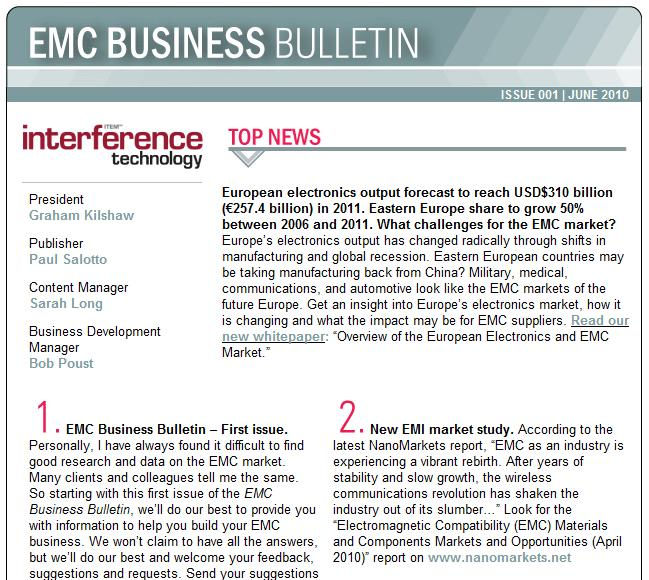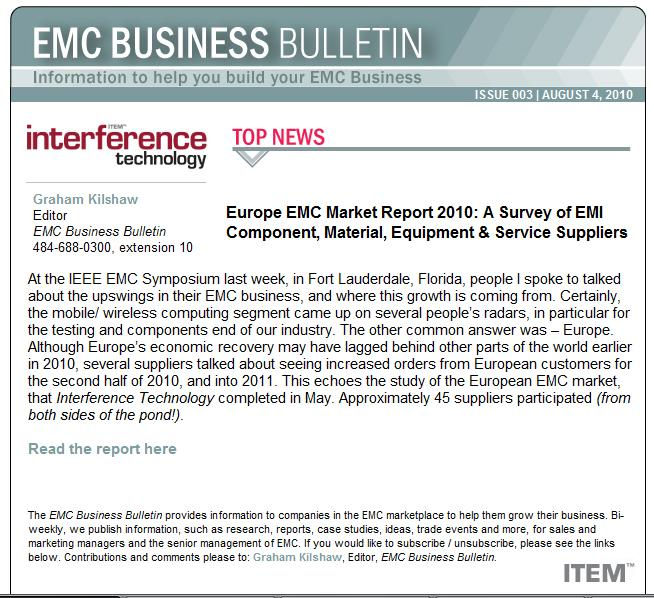Content Marketing Group Therapy: What Suggestions Do You Have for This eNewsletter?
- Fahad H

- Aug 23, 2010
- 4 min read
Several weeks ago, Joe and I received an email from Graham Kilshaw from Interference Technology. He believes in the power of content marketing and had recently launched an eNewsletter (titled the EMC Business Bulletin) to educate his prospects. The problem was that he wasn’t getting the results he expected.
As content marketers, we’ve all faced this same issue: We want to create content that is effective, but how do we do that? Graham offered to use his eNewsletter as a learning experience for the CMI community.
The premise is simple: He’ll share what he is doing with his newsletter and the results he is having. From there, we’d love to get feedback from the CMI community on how the newsletter can be improved. Graham will make changes and then report the findings in a future blog post. This way, we can all learn from our collective experience.
Getting started with the eNewsletter
Coincidentally, Interference Technology is a publisher, providing technical and business information to engineers and suppliers, and they sell advertising. As Graham was first to point out, some may think that publishers are natural content marketers, but this wasn’t the case for them. In fact, prior to the eNewsletter, Graham describes his marketing efforts as “old school,” and the “harder sell approach to marketing” that was very much focused on “us” instead of his prospects. They used things such as special offers, high email frequency, eBlasts, faxes, etc.
The eNewsletter that Graham developed was a definite shift. Not only is the content very different from the publication his company offers (instead of being very technical, the Bulletin provides industry information to advertisers and prospects), but it also diverges from the “hard sell” approach they had used with little to no success.
Graham initiated his eNewsletter in June and sent his second issue in July. When I first talked to Graham, he was disappointed by the initial two eNewsletters that he sent out. His first newsletter was a great deal of work as he curated a lot of information that he thought his prospects would find useful.

Making changes to the eNewsletter
On the positive side, Graham has the right mindset: He’s not using the newsletter to directly sell, but rather he’s providing info that is relevant to his prospects to educate them on the industry.
But, I also could see some room for improvement. After we talked, Graham made these changes to his newsletter.
Focused the content of the newsletter
While I could appreciate how much great information the newsletter had, my gut was that it was presenting too much; readers were not sure where to go. Additionally, finding this much new content for every newsletter can become a burden, so I suggested that Graham focus on one topic at time.
For the next newsletter, Graham decided to focus on one topic instead of six. Not only did this make the call to action more clear, but it also gave him flexibility to make the type larger. He also made the subject line specific to the featured content.

Included a personalized connection
I questioned Graham about the inclusion of the editorial box that was front and center of his original eNewsletter: Did this need to be taking up prime real estate above the fold? He explained that it was suggested that he include this because he is relatively well known in the industry and he thought that the inclusion of his name would give the eNewsletter more credibility.
I absolutely agree. If you are someone that your readers relate to, it’s great to provide the personalized connection in your eNewsletter. However, I thought that box was too prominent, so I suggested that it feature only him, which is a change he made (in future issues, he’ll include a picture as well). Additionally, he also changed the email so that it would come from him instead of from his company.
Added a footer Graham also added a footer to the eNewsletter that includes a brief description of what the Bulletin is about and who it is for. He also included clear opt out/opt in and forward to friend links.
Results
Here are some key metrics and results from the three newsletters that Graham has sent to date:
June edition Opens: 1550 Unique Opens: 684 Clicks on Europe Report (the main thing they are trying to drive traffic to): 32 July edition Opens: 943 Unique Opens: 520 Clicks on Europe Report: NA August edition Opens: 1231 Unique Opens: 705 Clicks on Europe Report: 138
The most positive improvement is that they received 12 requests for proposals, which Graham attributes directly to the eNewsletter.
While the eNewsletter didn’t have any sales information in it (a deliberate decision Graham made to make sure the content is seen as educational instead of “salesy”), they did follow up the eNewsletter with a simple text message that reminded advertisers and prospects about a pending deadline for a new European publication. As Graham explains:
“This two-tiered approach produced (now) 12 RFQs – more than we have received in a long, long time, in similar circumstances. The sales managers and I agreed that the reminder email would never have had such a positive effect if we had not used the Bulletin so effectively to build the brand, and build demand for our new Europe publication first. The lesson here we have learned is to separate the brand building messages (of our content marketing) from the sales messages – we think this is key, and we plan to replicate this strategy in the future.”
The initial results from the changes are positive, but there are always ways to improve – and we’d love your help.
My suggestion to Graham: Start doing some A/B testing to see what changes make a difference. Do you agree? What A/B tests would you suggest?
What other ideas do you have for Graham to improve his newsletter? Share them in the comments below. Graham will make some modifications and report back. Thanks to everyone for your suggestions!








Comments